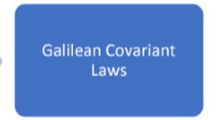Abstract
This paper aims to implement Bell’s notion of local causality into a framework, called local physical theory, which is general enough to integrate both probabilistic and spatiotemporal concepts and also classical and quantum theories. Bell’s original idea of local causality will then arise as the classical case of our definition. First, we investigate what is needed for a local physical theory to be locally causal. Then we compare local causality with Reichenbach’s common cause principle and relate both to the Bell inequalities. We find a nice parallelism: both local causality and the common cause principle are more general notions than captured by the Bell inequalities. Namely, Bell inequalities cannot be derived neither from local causality nor from a common cause unless the local physical theory is classical or the common cause is commuting, respectively.


Similar content being viewed by others
Notes
We note that our definition of a local physical theory does not embrace models beyond the Tsirelson bound. In order to incorporate also such models (Popescu–Rohrlich box) one should generalize the net of local algebras to a net of order-unit vector spaces. See (Summers and Werner 1987a) and (Popescu and Rohrlich 1994).
For the sake of uniformity we slightly changed Bell’s notation and figure.
References
Bell, J. S. (2004). Speakable and unspeakable in quantum mechanics. Cambridge: Cambridge University Press.
Butterfield, J. (1995). Vacuum correlations and outcome independence in algebraic quantum field theory. In D. Greenberger & A. Zeilinger (Eds.), Fundamental problems in quantum theory (pp. 768–785). New York: New York Academy of Sciences.
Butterfield, J. (2007). Stochastic Einstein locality revisited. British Journal for the Philosophy of Science, 58, 805–867.
Brunetti, R., Fredenhagen, K., & Verch, R. (2003). The generally covariant locality principle: A new paradigm for local quantum field theory. Communications in Mathematical Physics, 237, 31–68.
Cavalcanti, E. G., & Lal, R. (2014). On modifications of Reichenbach’s principle of common cause in light of Bell’s theorems. Journal of Physics A, 47, 424018.
Earman, J., & Valente, G. (2014). Relativistic causality in algebraic quantum field theory. International Studies in the Philosophy of Science, 28(1), 1–48.
Haag, R. (1992). Local quantum physics. Berlin: Springer.
Halvorson, H. (2007). Algebraic quantum field theory. In J. Butterfield & J. Earman (Eds.), Philosophy of physics (Vol. I, pp. 731–922). Amsterdam: Elsevier.
Henson, J. (2005). Comparing causality principles. Studies in History and Philosophy of Modern Physics, 36, 519–543.
Henson, J. (2013). Non-separability does not relieve the problem of Bell’s theorem. Foundations of Physics, 43, 1008–1038.
Hofer-Szabó, G., & Vecsernyés, P. (2012a). Reichenbach’s common cause principle in AQFT with locally finite degrees of freedom. Foundations of Physics, 42, 241–255.
Hofer-Szabó, G., & Vecsernyés, P. (2012b). Noncommuting local common causes for correlations violating the Clauser-Horne inequality. Journal of Mathematical Physics, 53, 12230.
Hofer-Szabó, G., & Vecsernyés, P. (2013a). Noncommutative common cause principles in AQFT. Journal of Mathematical Physics, 54, 042301.
Hofer-Szabó, G., & Vecsernyés, P. (2013b). Bell inequality and common causal explanation in algebraic quantum field theory. Studies in the History and Philosophy of Modern Physics, 44(4), 404–416.
Hofer-Szabó, G., Rédei, M., & Szabó, L. E. (2013). The principle of the common cause. Cambridge: Cambridge University Press.
Hofer-Szabó G. (2015). Local causality and complete specification: A reply to Seevinck and Uffink. In U. Mäki, I. Votsis, S. Ruphy, & G. Schurz (Eds.), Recent Developments in the Philosophy of Science: EPSA \(_\mathit{13}\) Helsinki (pp. 209–226). Switzerland: Springer.
Hofer-Szabó, G., & Vecsernyés, P. (2015). On Bell’s local causality in local classical and quantum theory. Journal of Mathematical Physics, 56, 032303.
Norsen, T. (2009). Local causality and completeness: Bell versus Jarrett. Foundations of Physics, 39, 273.
Norsen, T. (2011). J.S. Bell’s concept of local causality. American Journal of Physics, 79, 12.
Popescu, S., & Rohrlich, D. (1994). Quantum nonlocality as an axiom. Foundations of Physics, 24, 379–385.
Rédei, M. (1997). Reichenbach’s common cause principle and quantum field theory. Foundations of Physics, 27, 1309–1321.
Rédei, M., & Summers, J. S. (2002). Local primitive causality and the common cause principle in quantum field theory. Foundations of Physics, 32, 335–355.
Rédei, M. (2014). A categorial approach to relativistic locality. Studies in History and Philosophy of Modern Physics, 48, 137–146.
Reichenbach, H. (1956). The direction of time. Los Angeles: University of California Press.
Ruetsche, L. (2011). Interpreting quantum theories. Oxford: Clarendon Press.
Seevinck, M. P., & Uffink, J. (2011). Not throwing out the baby with the bathwater: Bell’s condition of local causality mathematically ’sharp and clean’. In D. Dieks, W. J. Gonzalez, S. Hartmann, Th Uebel, & M. Weber (Eds.), Explanation, prediction, and confirmation the philosophy of science in a European perspective (Vol. 2, pp. 425–450). Dordrecht: Springer.
Summers, S. J., & Werner, R. (1987a). Bell’s inequalities and quantum field theory, I: General setting. Journal of Mathematical Physics, 28, 2440–2447.
Summers, S. J., & Werner, R. (1987b). Bell’s inequalities and quantum field theory, II: Bell’s inequalities are maximally violated in the vacuum. Journal of Mathematical Physics, 28, 2448–2456.
Summers, S. J., & Werner, R. (1988). Maximal violation of Bell’s inequalities for algebras of observables in tangent spacetime regions. Annales de l’Institut Henri Poincaré - Phys. Théor., 49, 215–243.
Summers, S. J. (1990). On the independence of local algebras in quantum field theory. Reviews in Mathematical Physics, 2, 201–247.
Summers, S. J. (2009). Subsystems and independence in relativistic microphysics. Studies in History and Philosophy of Modern Physics, 40, 133–141.
Uffink, J. (1999). The principle of the common cause faces the Bernstein paradox. Philosophy of Science, 66, 512–525.
Acknowledgments
This work has been supported by the Hungarian Scientific Research Fund OTKA K-100715 and K-108384, and the National Research, Development and Innovation Office, K-115593.
Author information
Authors and Affiliations
Corresponding author
Rights and permissions
About this article
Cite this article
Hofer-Szabó, G., Vecsernyés, P. A generalized definition of Bell’s local causality. Synthese 193, 3195–3207 (2016). https://doi.org/10.1007/s11229-015-0925-8
Received:
Accepted:
Published:
Issue Date:
DOI: https://doi.org/10.1007/s11229-015-0925-8




